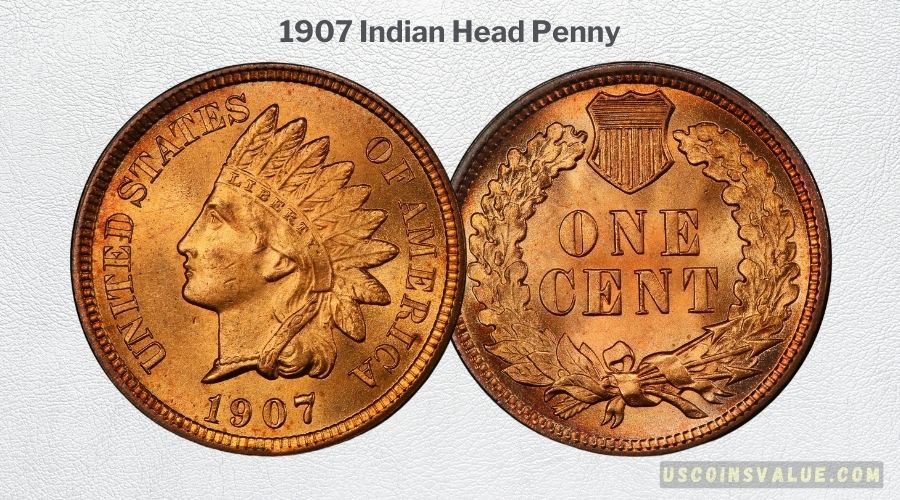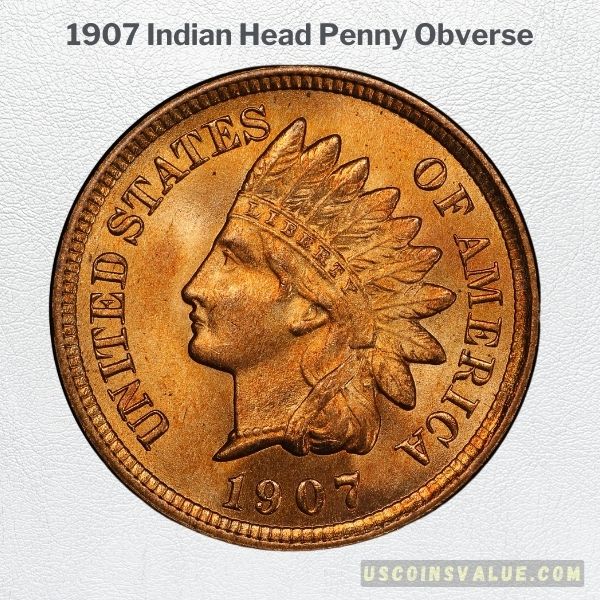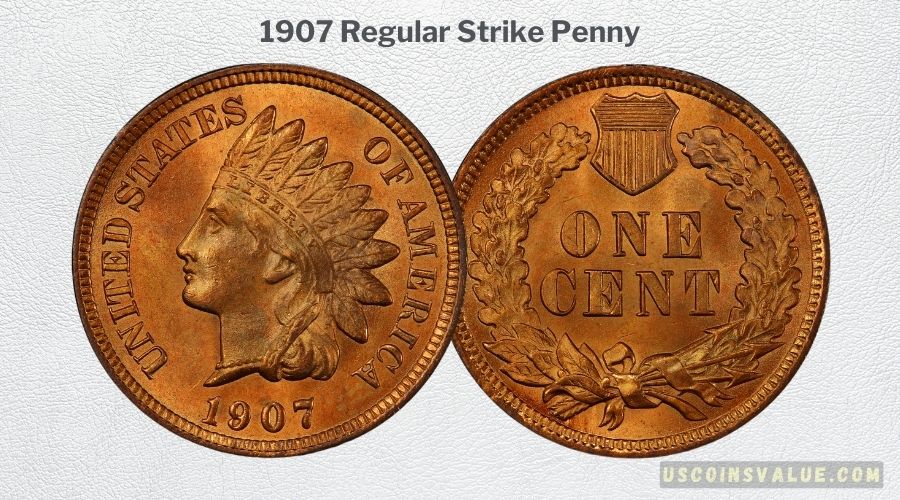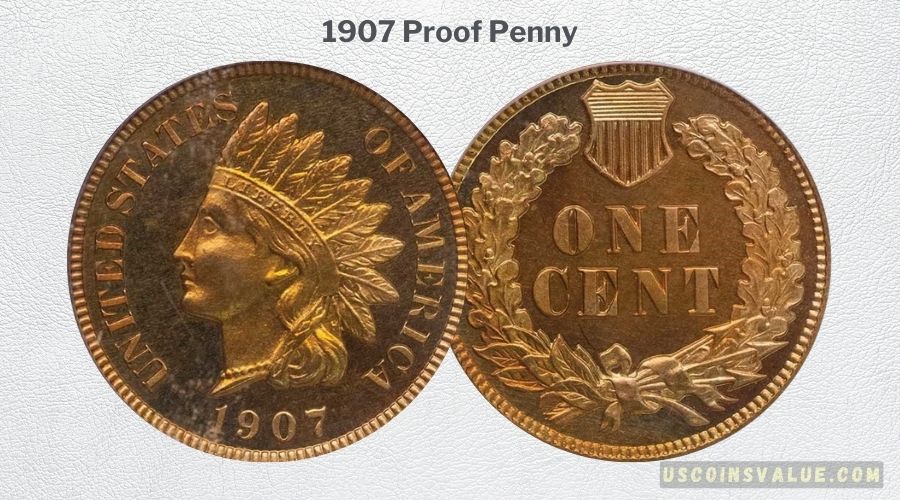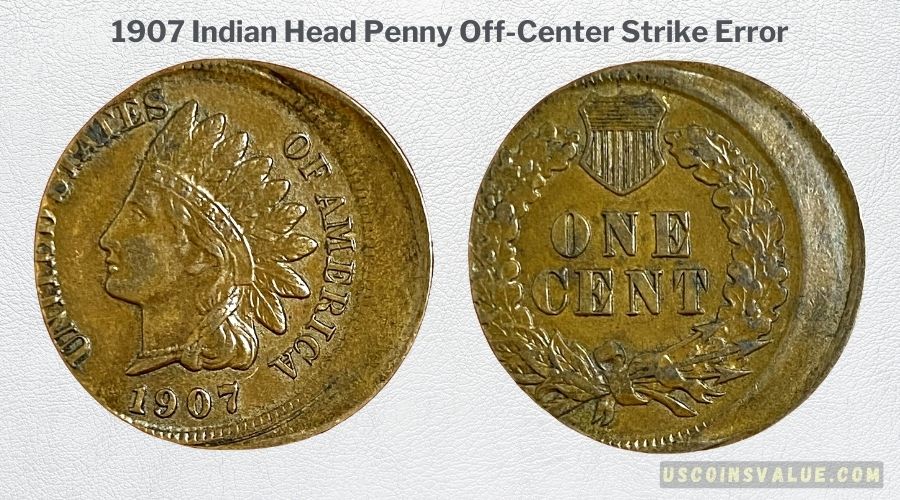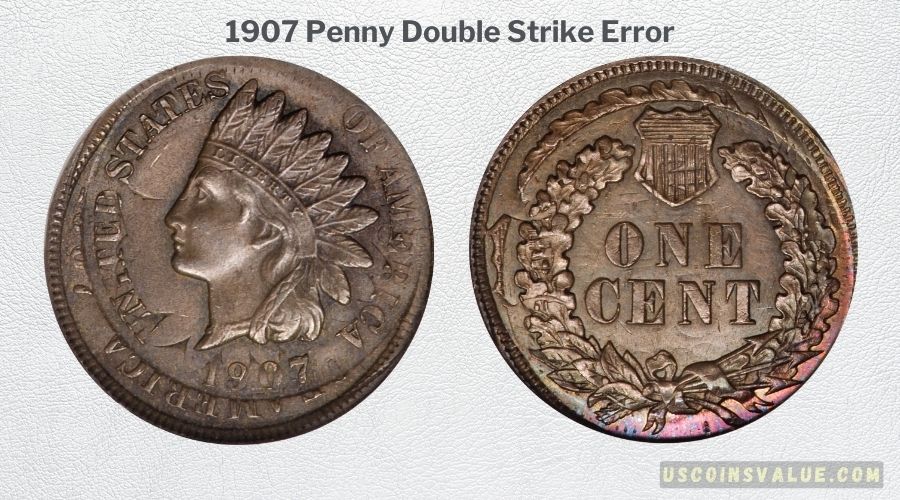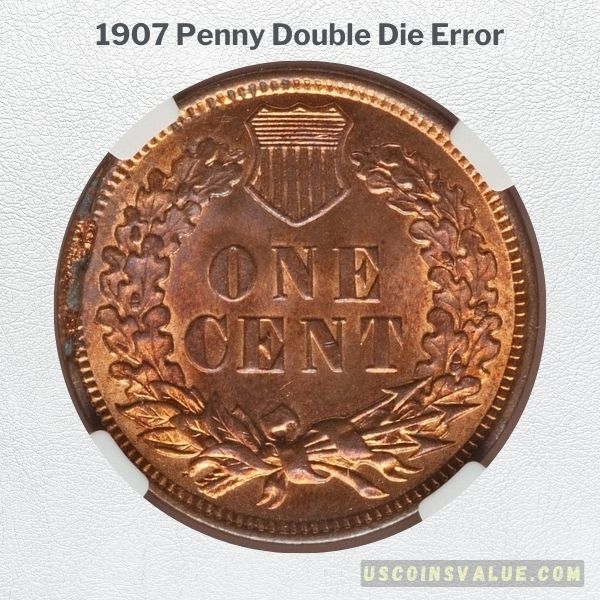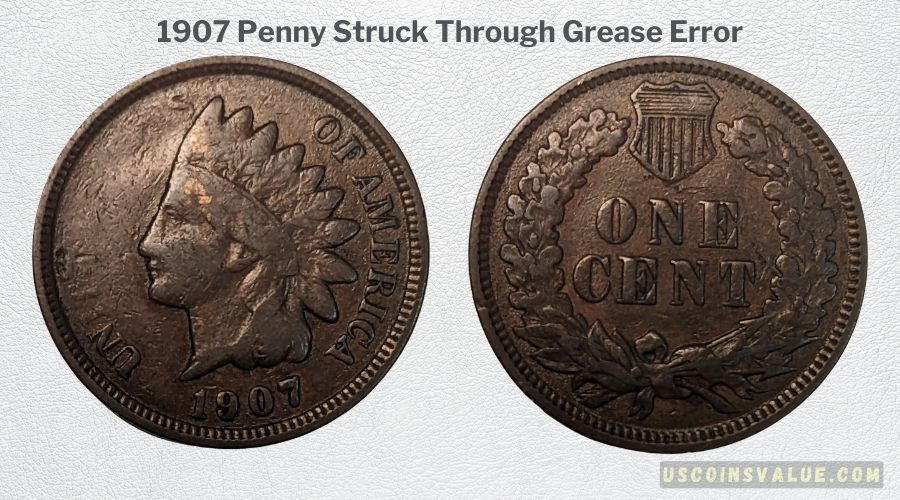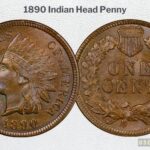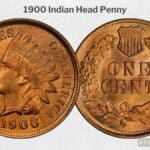Today, we’re discussing the famous and well-sought-after 1907 Indian Head Penny. This coin reigned supreme in the country for 50 years before losing steam to Lady Liberty.
If you’re interested in adding the 1907 Indian Head Penny to your collection, there are a few things to note. The coin’s value lies in its quality, and you can get as much as $63,000 for a mint state Indian Head Penny in color red.
Last year, Heritage Auctions sold a 1907 Indian Head Penny for $25,200 while this year a lesser valued piece raked in only $1,440. How do you know which variety will rake in thousands of dollars in today’s market?
This review includes all varieties of the 1907 Indian Head Penny, the possible errors, and auction history. Ultimately, you will know if your coin is valuable or worthless. Let’s begin.
What is the Background of the 1907 Indian Head Penny?
From 1859 – 1909, the US used the iconic Indian Head as the face of its cents, making it the longest-running series in the country. It also means the 1907 Indian Head Cent is one of the last mintage of that era.
Coincidentally, the country reached peak immigration in 1907, causing an increase in low-income spenders and earners. That ripple effect saw the increased mintage of low coin denominations, including the 1C Indian Head Penny.
James B. Longacre designed the head of a native Indian chief that covered the coin’s front and the leaf design on the back. He drew inspiration from the previous Flying Eagle series by copying the size in weight and diameter.
Longacre also used the same composition as the former coins. He later reduced the 1907 Indian Head Penny to 3.11g to meet growing demand and maintain favorable production costs. It worked because the Indian Head Penny lasted for 50 years.
Let’s dissect the physical features of the 1907 Indian Head Penny for easy identification.
The 1907 Indian Head Penny Features
- Series: Indian Head
- Year of Make: 1907
- Mintage: 108,137,143
- Mint Branch: Philadelphia,
- Composition: 95% Copper, 5% Tin & Zinc | Bronze
- Weight: 3.11g
- Diameter: 19mm
- Edge: Plain
Now let’s discuss the details.
Obverse & Reverse Design: What Does the 1907 Indian Head Penny Look Like?
You can already guess the engraving on the front of the 1907 Indian Head Penny from its name. It has the head of an Indian chief looking left and wearing the traditional headgear. There’s graffiti of tiny dotted circles along the diameter of the obverse and reverse.
- LIBERTY: “LIBERTY” is on the base of the crown in capital letters.
- UNITED STATES OF AMERICA: There’s an engraving of “UNITED STATES” curved in front of the chief’s face and “OF AMERICA” curved behind her head.
- 1907: Beneath the chief’s neck, there’s a bold inscription of the year “1907”
- Mint Mark:
On the reverse there are less written words but more images.
- ONE CENT: Written boldly in the center is “ONE CENT”.
- Shield: There’s a Presidential coat of arms.
- Olive Wreath: There’s a leaf wreath formed in a circle around the engraving of “ONE CENT” and the coat of arms.
- Three Arrows in a Ribbon: Three arrows wrapped in a ribbon are at the base of the leaf wreath.
What are the 1907 Indian Head Penny Varieties?
You can distinguish 1907 Indian Head Pennies through their colors unlike others that require mint marks. But the major difference is between the coin strike type.
You can either get the regular strike coins that come in red, brown or red & brown, or the Proof strike Indian Head 1C coins. The Proof coins come in four colors including the original red, brown, red & brown, and the unique cameo.
When shopping, you can distinguish them with the following names:
- 1907 RD – “RD” means Red.
- 1907 RB – “RB” means Red & Brown.
- 1907 BN – “BN” means Brown.
- 1907 PFRD – “PFRD” means Proof Red Indian Head Penny
- 1907 PFRB – “PFRB” means Proof Red & Brown.
- 1907 PFBN – “PFBN” means Proof Brown.
- 1907 CAM – “CAM” means Cameo.
They all came from the Philadelphia Mint, so there was no need for the “P” mint mark. Denver wasn’t minting Indian Head cents as of 1907, and the San Francisco minting facility wasn’t authorized to mint coins until 1908.
Meanwhile, these varieties exist for both Proof and Regular Strike pieces. Proof coins are limited series minted to test new designs, while the Regular Strike coins are circulated for commercial use. That’s why the Proof mintage is significantly less than its counterpart.
Take a look;
| 1907 (Indian Head) Penny Varieties | Mint Location | Mintage |
| 1907 1C (Regular Strike) | Philadelphia | 108,137,143 |
| 1907 1C (Proof) | Philadelphia | 1,475 |
What’s the Current Value of the 1907 Indian Head Penny?
The regular strike red 1907 Indian Head Penny is the most valuable variety, especially in Mint State. It pulled the highest figure at auction in
The next best variant is the red and brown penny, while the pure brown pieces are the least collectible.
We measure coin values on the Sheldon scale of 0 – 70, where 0 is poor, and 70 is proof of stellar condition. Most valuable coins fit on the scale of MS60 – 70, and PF60 – 70.MS means Mint State, while PF is for Proof.
| Grades | 1907 Indian Head
Regular Strike |
1907 Indian Head
Proof Strike (PF) |
| 60 | 52 – 60 | N/A |
| 61 | 56 – 70 | 190 |
| 62 | 65 – 115 | 200 – 250 |
| 63 | 80 – 200 | 250 – 350 |
| 64 | 125 – 400 | 300 – 585 |
| 65 | 240 – 900 | 475 – 1400 |
| 66 | 2,000 – 4,000 | 900 – 2700 |
| 67 | 27,500 – 65,000 | 2,200 – 10,500 |
This price guide is a compilation of updates from reputable coin appraisers including PCGS, NGC Coin and the USA Coin Book.
Regular Strike 1907 Indian Head Penny (RD, RB, BN)
The regular strike 1907 Indian Head Penny came in three colors including red, brown and red & brown. Each color carries a different value because of its rarity and grade.
The red variety has a rich, earthy burnt orange color. Because of age, many of the red varieties in excellent condition have lighter and shinier centers than their edges.
It’s even more valuable when your 1907 RD Indian Head Penny is proof. You can make up to $10,000 at auction. In 2019 Heritage Auctions sold an MS67 RD 1907 Indian Head coin for $63,000.
The Red & Brown 1907 regular strike Indian Head Penny has a unique shiny brown color with slight red blotches on parts of its engraving.
You’ll mostly see the red stains on the Indian chief’s face and in the crevices of the words “ONE CENT,” “UNITED STATES OF AMERICA,” and “1907”.
Sometimes, the red blotches extend to the other details on the reverse, like the wreath and shield. In 2018, Legend Rare Coins Auctions sold an MS66RB 1907 Indian Head Penny for $715 and another for $688 the following year.
The brown 1907 Indian Head Pennies have a single dark brown color. But age, time, and wear can cause parts of it to become lighter and shinier. When that happens, it retains its brown tone even though they’re lighter.
Brown 1907 Indian Head Pennies are the least valuable variant, but that doesn’t mean you can’t make some dollars from them at auction. An MS64 piece sold for $504 this 2023, which is more than its 2014 $382 value. See the table below for more info.
| Grade | Highest Price & Sale Date | Firm |
| RD, MS67 | $25,200 (2022) | Heritage Auctions |
| RD, MS66 | $2,100 (2022) | David Lawrence |
| RB, MS66 | $715 (2017) | Legend Rare Coin Auctions |
| BN, MS64 | $504 (2023) | Stack’s Bowers |
| BN, MS64 | $382 (2014) | Heritage Auctions |
1907 Indian Head Penny (Proof Strike)
Firstly, you must understand that the Proof 1907 Indian Head Penny is rare. That’s because the initial production had only 1,475 mintage and wasn’t available to the public. Proof coins are made especially for collectors and as prototypes of new designs.
This variety comes in four colors: brown to red, red & brown, and cameo.
The brown Proof 1907 Indian Head coin has an interesting purple and blue patina and glossy finish.
The red & brown Proof variant mostly looks like a shiny bronze-gold coin with patches of red patina on the engravings. Meanwhile, the red color is a fiery orange-red with a sunny glow in its Mint State.
Unlike the other three colors, cameo is an effect. It can happen to only any proof coins, whether the 1907 1C RD, BN, or RB. Cameo-proof coins typically have frosted finishing while the surrounding background, a.k.a. the field, reflects like a mirror.
The highest amount a proof 1907 Indian Head Penny fetched at auction was almost $23,000 in 2019, a red variant. Two years before, a CAM PR66 1907 Indian Cent sold for a little over $11,000.
Unfortunately, the Proof pieces that sold this year didn’t make as much. They sold for less than $1,500 at auction because they had less quality than the 2017 – 2019 coins.
Check out this table for more pricing info.
| Grade | Highest Price & Sale Date | Firm |
| RD, PR67 | $22,912.50 (2019) | Legend Rare Coin Auctions |
| CAM, PR66 | $11,163 (2017) | Legend Rare Coin Auctions |
| RD, PR67 | $5,581 (2013) | Heritage Auctions |
| CAM, PR66 | $5,040 (2019) | Stack’s Bowers |
| BN, PR66 | $2,640 (2019) | Heritage Auctions |
| RD, PR65 | $1,020 (2023) | Heritage Auctions |
Common Errors You’ll Find in the 1907 Indian Head Penny
Although minting plants aspired to perfection on all coins, some inevitable errors occurred during production. Once these mistakes happened, the US Mint typically recalled the coins from circulation or prevented them from leaving the facility.
As such, 1907 Indian Head Pennies with errors are rare and, by extension, valuable. It’s not always worth more than regular strike pieces in excellent condition, but it’ll fetch you some more dollars than an average 1907 Indian Head Penny.
Some common errors you’ll find on coins include:
- Off-Center Strike Error
- Double Minting Error
- Double Strike Error
- Double Die Error
- Struck Through Grease Error
Off-Center Strike Error
The major details on the obverse and reverse of the 1907 Indian Head Penny are central. So, when you see the chief’s head or “ONE CENT” off its mark, there’s an off-center strike error.
Off-center strikes can be slight at 1% – 5% or extreme at 15% – 20%, where almost half the coin is left blank. It occurs when the planchet shifts, causing the strike to miss its designated center position.
Here’s what you can make from having an off-center strike 1907 Indian Head Penny.
- A 15% off-center struck 1907 Indian Head Penny sold for $1,292.50 in 2016.
- In 2005, a 1907 Indian Head cent struck 50% off-center sold for $1,092.50.
Double Minting Error
Sometimes, there can be double minting on one coin in the production rush. In this case, you’ll see duplicated details such as date numbers and letters.
Typically, you won’t notice this error without a magnifying glass because of the positioning. But in rare cases, they’re visible. Auction houses list this error as “RPD,” meaning RePunched Date, so look out for that before bidding.
While it’s an aesthetic eyesore, this error can fetch you more than double a coin’s true value, including the 1907 Indian Head Penny. Here are some examples sold recently:
- A 1907 Indian head cent with an RPD error graded MS60 sold for $25 in 2005.
Double Strike Error
Like the double minting error, the double strike mistake happens when the mechanism hits the planchet twice. This causes detailed duplication and can be on the front or back of the coin.
Sometimes, the error doesn’t cause duplication of details but missing details and a dented coin. You’ll find that parts of the 1907 Indian Head Penny will miss important surface details and have bent diameters.
You must note that missing letters from double-strike errors aren’t the same as faded letters from wear and tear. Be careful not to mix up both defects.
Examples of Double Strike
- A 50% double struck 1907 Indian Head Penny sold for $1,265 in 2012.
- In 2008, a 1907 Indian head penny with a 10% double struck error sold for $862.50.
Double Die Error
Every coin has a measured composition of materials, including the die used for minting the engravings. When this die isn’t manufactured properly, the mintage risks double die errors on the obverse (DDO) or reverse (DDR).
Double Die error causes the coin to have duplicated images where there should be one. You won’t see a literal dual head, but the patina will have two colors, making a single image appear as a doubled one.
- In 2021, a 1907 Indian head penny with a reverse lamination error sold for $144.
Struck Through Grease Error
A struck-through grease error is a manufacturing mistake caused by grease spillage into the die mechanism. It occurs when there’s overpolishing of the die. So, during the strike, the image appears weaker than it should be, making it look smudged.
For this error, the coin comes out with missing details such as an engraved date or word. You can now reconcile the name with the error as the strike hits grease instead of die. A few 1907 Indian Head Pennies came out through this misformed process.
Here’s how much you can make if you have such a coin:
- In 2021, a struck through capped die 1907 Indian head cent sold for $408.
- Another 1907 Indian head cent with a struck through capped due error sold for $402.50.
Final Thoughts
There’s no denying that the 1907 Indian Head Penny or Cent is a valuable collectible coin. But from this review, you must remember that its value mainly lies in its patina and quality. The 1907 RD is worth the most money, and it’s even better if it’s a proof coin.
The 1907 RB, a.k.a. Red & Brown Indian Head pennies, are a close runner-up in value, while the BN variant is the least valuable.
Finally, ensure you appraise your coin with reputable organizations like NGC Coins and PCGS to get the best current value for sale and purchase.

